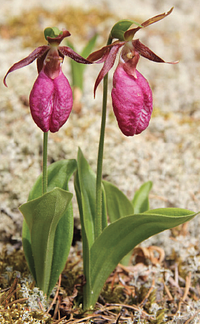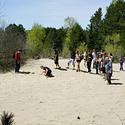Environmental Restoration at the Pinhey Sand Dunes

The pink ladyslipper orchid can be found in the sandy soil in the forests and near the edges of the Pinhey sand dunes. They bloom in late May and early June.
Cette promenade a également lieu en français.
The Pinhey Sand Dunes are an unusual micro-environment and a rare feature of Ottawa's ecology. These restored open sandy areas represent only a small fraction (about 1%) of the original four square-kilometre inland sand dune system, a consequence of the prehistoric Champlain Sea. Through the efforts of the Biodiversity Conservancy , a rare and unique dry-land habitat and ecosystem have been restored to enrich the biological and habitat diversity of the the National Capital Greenbelt.
The dune organisms are mostly insects, spiders, and other arthropods, which have developed an extraordinary ability to live in an extreme dune environment where, during the summer, (i) the sun is fiercely bright and hot; (i) sand temperatures can soar to over 70°C; (iii) winds can be at times gusty enough to cause local dust storms and dust devils; and (iv) the insects and plants are constantly being bombarded with abrading sand grains or buried under shifting sands.
The first week of May is a bit too early to see activities of many sand dune organisms. If we get a warm sunny day, we may see some insects such as the Big Sand Tiger Beetle, Cicindela Formosa, running here and there. In any case, you will enjoy seeing and learning about the Pinhey sand dunes, how they were formed, and the restoration process. Some of the dune wildflowers may have started already due to the warm weather this year, and some of the spring insects will likely be visible, including some bees and butterflies. A walk across the dunes and through part of the Pinhey Forest will reveal the early spring wildflowers on the forest floor.
The Pinhey Dunes is an unusual habitat requiring our help to maintain it, as otherwise it would soon disappear, as indeed it nearly did. You can learn more about the Pinhey Sand Dunes online here. A photo essay on plant and insect species living in the dune can be found here, including some short videos.

